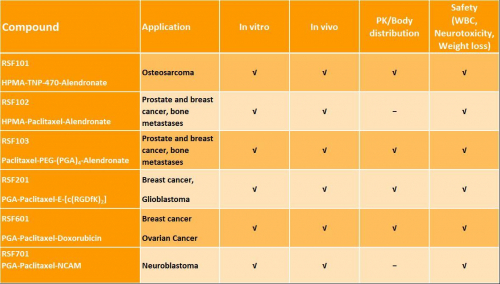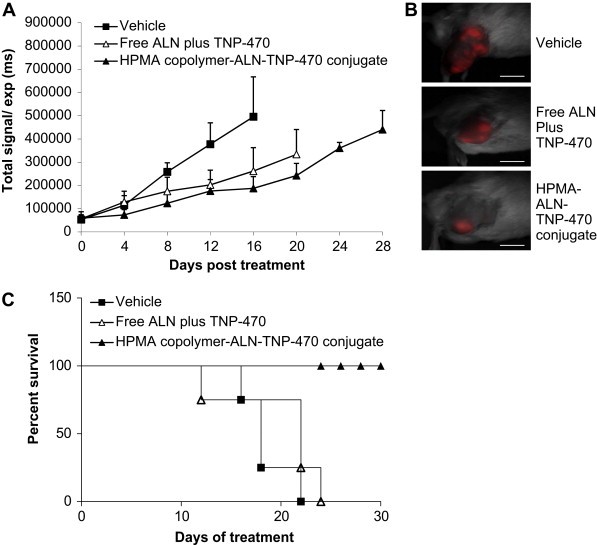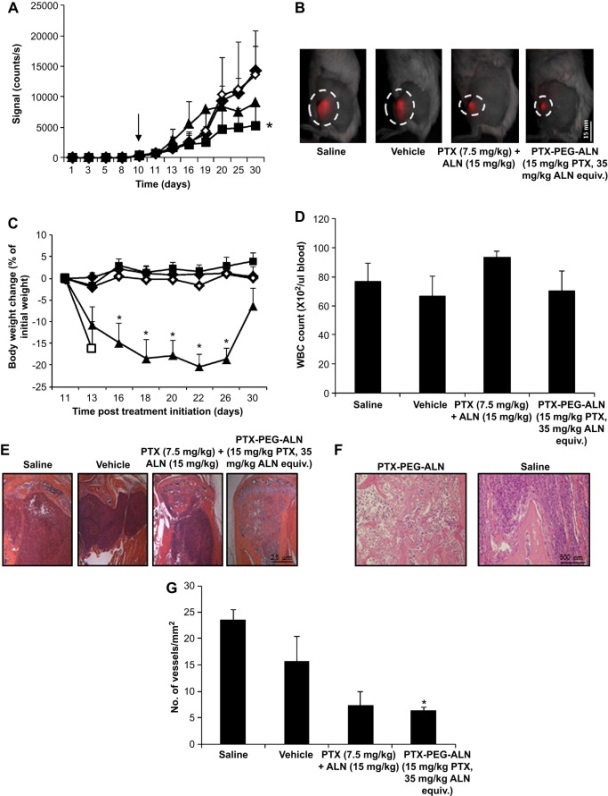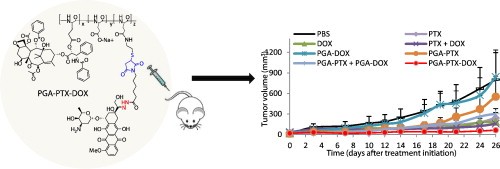- RAMOT at Tel Aviv University Ltd.
- From Israel
- Responsive
- Innovative Products and Technologies
Summary of the technology
A new platform technology for the treatment of cancer and bone metastases was developed using combined targeted polymeric drug delivery system with chemotherapeutics and angiogenesis inhibitors. The novel compounds are composed of three main elements:
1.Water-soluble synthetic copolymer such as HPMA (N-(2-hydroxypropyl)methacrylamide) or PGA (polyglutamic acid) as specific carrier enabling the molecules to extravasate from the tumor leaky vessels and internalize into the tumor endothelial and epithelial cells.
2. Specific targeting moieties - Bisphosphanates such as alendronate (ALN) for bone metastases and osteosarcomas or RGD peptidomimetics targeting integrins overexpressed in various tumors.
3. Specific angiogenesis inhibitors, such as TNP-470, a low molecular weight analogue of Fumagilin, that was demonstrated as a selective inhibitor of angiogenesis, or known chemotherapy agents such as Paclitaxel (PTX), that were demonstrated as inhibitors of angiogenesis when given at an "anti-angiogenic dosing schedule" (administration of chemotherapy at low doses, well below the maximum tolerated dose, in close intervals for extended periods of time – “metronomic dosing”).
Project ID : 10-2008-86
Details of the Technology Offer
Anti-cancer NanoTherapy
Utilizing unique nano-technology to develop targeted combination nanomedicines that were shown to be synergistic, effective and safe for treating cancer
Technology
We have developed a new platform technology for the treatment of cancer and bone metastases using combined targeted nano-sized polymers that deliver chemotherapeutics creating a new class of effective and safer molecules. The novel compounds are composed of three main elements:
- Water-soluble synthetic copolymer such as HPMA (N-(2-hydroxypropyl)methacrylamide), PEG-PGA dendron self-assembled micelles (Polyethyleneglycol-4(polyglutamic acid)dendron) or PGA (polyglutamic acid) as selective multivalent carriers enabling the molecules to extravasate from the tumor leaky vessels and internalize into the tumor endothelial and epithelial cells via the enhanced permeability and retention (EPR) effect.
- Specific targeting moiety – Amino-bisphosphonates such as alendronate (ALN) for bone metastases and osteosarcomas, or RGD peptidomimetic for αvβ3 integrin overexpressed in tumor endothelial cells or NCAM-targeting peptide for glioblastoma, neuroblastoma and renal cell carcinoma overexpressing NCAM.
- Specific angiogenesis inhibitors, such as TNP-470, a low molecular weight analogue of Fumagilin, or known chemotherapy agents such as doxorubicin (DOX) or Paclitaxel (PTX).
The Need
Cancer is the leading cause of death in many places across the globe. Most cancer patients do not die due to primary tumor mass, but rather from complications caused by metastases to vital organs, mainly to the bones. Chemotherapy agents, hormonal deprivation and bisphosphonates are the common treatments for advanced metastatic disease and bone neoplasms. However, these drugs suffer from significant safety issues. In addition, with time, the disease progresses to a phase when the standard therapy fails to control the malignancy and further progresses to a highly chemotherapy-resistant state.
Although combination therapy is a common practice in oncology, the optimal and effective utility of this practice is hampered by many challenges such as different pharmacokinetic (PK) profiles and delivery mechanisms. Our technology has the potential to (1) overcome this drug resistance, (2) offer effective means for selective delivery, (3) maximize/synergize effects of combined chemotherapy and anti-stroma drugs.
Products
The current pipeline consists of six novel molecules divided into two main drug families, as illustrated in the table below:

Bone-targeted molecules (consisting of alendronate as the bone-targeting moiety), divided into few subcategories:
a. Paclitaxel-based nanomedicines conjugated to the polymeric backbones:
i. HPMA copolymer (compound RSF 102)
ii. PEG-PGA dendron (compound RSF 103)
b. TNP-470-based nanomedicines conjugated to the polymeric backbone HPMA copolymer (compound RSF 101)
Molecularly-targeted and tumor tissue targeted conjugates:
a. Integrin-targeted molecule (E-c(RGDfK)2) containing Paclitaxel as the active drug and conjugated to PGA (compound RSF 201).
b. Dual active drug (Doxorubicin and Paclitaxel) conjugated to PGA (compound RSF 601).
c. NCAM-targeted molecule containing paclitaxel as the active drug and conjugated to PGA (compound RSF 701).
Unique advantages
All nanotherapies were shown to be synergistic, more effective and less toxic than the combination of the free drugs or combination of separate conjugates of each drug. Moreover, when compared against other approaches using a conjugated molecule, our molecule showed better efficacy and safety.
Rich Licensing package for each product that includes:
• Established synthesis route
• In-vitro cell cytotoxicity
• In-vitro hemcompatibility
• In-vivo efficacy data in
• Pharmacokinetics characterization
• Biodistribution characterization
• In-vivo efficacy in breast cancer models
• Safety- follow up on body weight
Patents
Five patent families are currently pending worldwide, covering composition of matter and the various applications
Product highlights
HPMA copolymer-Alendronate-TNP-470 Conjugate (RSF101)
HPMA copolymer-ALN-TNP-470 conjugate inhibits K7M2 murine osteosarcoma and prolong the survival rate of the mice.

Enhanced anti-tumor activity and safety profile of targeted nano-scaled HPMA copolymer-alendronate-TNP-470 conjugate in the treatment of bone malignances. Biomaterials, Volume 32, Issue 19, 2011, 4450 – 4463
Targeting angiogenesis-dependent calcified neoplasms using combined polymer therapeutics, PLoS ONE, 4(4):e5233 (2009).
HPMA Copolymer–Paclitaxel–Alendronate Conjugate (RSF102)

Targeting bone metastases with bi-specific anticancer and anti-angiogenic polymer-alendronate-taxane conjugate, Angewandte Chemie-International Edition English 48(16), 2949 –2954 (2009).
Antiangiogenic antitumor activity of HPMA copolymer-paclitaxel-alendronate conjugate on breast cancer bone metastasis mouse model. Mol Pharm. 2011 Aug 1;8(4):1052-62.
Poly (ethylene glycol)-Paclitaxel-Alendronate (RSF103)

Anti-tumor efficacy and toxicity of PTX–PEG–ALN conjugate on a xenograft model of mCherry-labeled MDA-MB-231 mammary adenocarcinoma in the tibia resistant to paclitaxel. PTX–PEG–ALN conjugate exhibited superior antitumor efficacy, inhibiting 50% of tumor growth, as compared to saline- and paclitaxel-treated control mice
Poly(ethylene glycol)–paclitaxel–alendronate self-assembled micelles for the targeted treatment of breast cancer bone metastases. Biomaterials, Volume 34, Issue 15, 2013, 3795 – 3806.
Dendritic Poly(ethylene glycol) Bearing Paclitaxel and Alendronate for Targeting Bone Neoplasms, Molecular Pharmaceutics, 8(4):1063-1072 (2011).
Polyglutamic Acid (PGA)- Paclitaxel -E-[c(RGDfK)2] (RSF201)
A polymer and an integrin-targeted paclitaxel. PGA-PTX-E-[c(RGDfK)2] blocked endothelial cells migration and capillary-like tube formation. Orthotopic studies in mice barring aggressive murine 4T1 breast cancer tumors demonstrated preferential tumor accumulation of the RGD-bearing conjugate, leading to enhanced anti-tumor efficacy and a marked decrease in toxicity as compared with free PTX-treated mice.
Integrin-assisted drug delivery of nano-scaled polymer therapeutics bearing paclitaxel. Biomaterials. 2011 May; 32(15):3862-74
Polyglutamic Acid (PGA)–Paclitaxel–Doxorubicin Conjugate (RSF601)

Anticancer polymeric nanomedicine bearing synergistic drug combination is superior to a mixture of individually-conjugated drugs. Journal of Controlled Release, Volume 187, 2014, 145 – 157 (selected for Cover and Editorial highlight).
Polyglutamic Acid (PGA)-Paclitaxel- NCAM targeting peptide (RSF701)

A polymer conjugate of paclitaxel and NCAM-targeting peptide with polyglutamic acid backbone was rationally-designed, synthesized and characterized. The targeted conjugate bound to NCAM-expressing cells and inhibited their proliferation and migration more than control conjugates. Furtheremore, it inhibited capillary-like tube formation of HUVEC. The targeted conjugate inhibited the growth of orthtopicaly-implanted mCherry-labeled neuroblastoma tumors in mice more than control conjugates and was better-tolerated than free paclitaxel.






